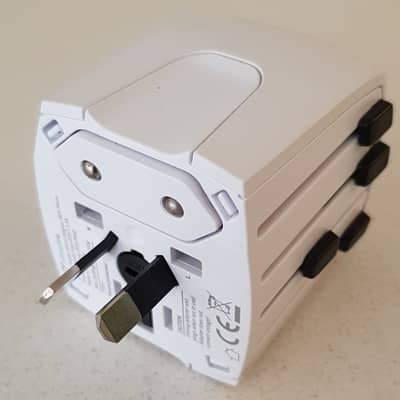Traveling in New Zealand and Australia and not sure what type of power adapter to bring? Here’s your guide to device compatibility, plug and power systems.
Voltage in New Zealand and Australia is 230-240 volts. Many US electrical devices (like laptops and phones) are compatible because they are dual voltage across 110 and 240v. However you will need a travel adapter because of the nature of the plug and wall sockets in New Zealand and Australia generally angled and 3-pronged.
Here’s some more detail on how to avoid mistakes when using the New Zealand and Australian power supply.
What is the electricity voltage in New Zealand and Australia?
New Zealand and Australia, like most of Asia, Europe and many other countries use 220 and 240 volts.
North America, Canada, Mexico, South America, along with the Carribean and Japan use around 110 volts.
Electrical Equipment in NZ and Oz – What to bring?
Many of the devices you travel with will be dual voltage.
Dual voltage describes any type of electronic device whose manufacturer has built in the ability to be used with both 110-120 volts and 220-240 volts.
This includes many different electronic devices, portable and small appliances such as your:
- Laptop and tablet
- Mobile phone/Cell phone
- Digital camera
- Electric toothbrush
- Shaver and electric razor
- USB chargers
- Battery chargers
Many of these devices switch automatically from from 110 volts to 240 volts. There is nothing you need to do.
Naturally, any items powered by a USB charger will be fine to use.
But this may not apply to your hair dryer or rice cooker which relies of a heavier current to create the heat necessary to dry your hair or cook your rice.
But there are travel hair dryers that are dual voltage.
Here’s the 10 Best Travel Hair Dryers with Dual Voltage (2021)
What happens if you plug into the wrong voltage?
A few things can happen.
You’ll destroy your device, either immediately or after a period.
It just won’t work.
Worse case, you’ll cause a fire.
It’s not worth the risk!
Take the time to check for the correct voltage.
How do you know if your device is dual voltage?
If the device is dual voltage it will be labeled on it somewhere.
Look for a some writing or label on the plug or cord, on the device itself, or under the battery cover.
It will say something like INPUT 110-240v or “wide range input”.
If you’re not sure check the manufacturer’s website.
If you are travelling to the United States, you can purchase a step-down voltage converter to convert 220v to 110v which you may want to do for large appliances such rice cookers, vacuum cleaners etc.
Step-up converters are a bit more complicated, and expensive.
You may be better to purchase new equipment from local stores for use in New Zealand and Australia.
The easiest things to do is stick with dual voltage devices, then you only need a compact plug adapter.
Will my existing 220 volt devices work in New Zealand, and Australia?
Yes, your 210/220 device or appliance will work in New Zealand, and Australia.
New Zealand sockets and Australia sockets are the same.
But maybe the plug is different.
Plug adaptors for New Zealand and Australian power sockets
The most useful item to carry when traveling is a universal plug adapter.
It’s a handy little cube that contains the various fittings for variety of sockets and plugs.
Because while many countries have the same voltage, they do have different power sockets and plugs.
A universal adapter will allow you to switch instantly to a different plug format . Many also contain USB ports.
Here’s my universal adapter which measures about 1½ ins (4 cm) each way.


If you can’t find a universal adapter, search for a ‘Type A/B to Type C Adapter’ or a ‘US to AU/NZ Adapter.
(Some hotels and motels provide 110 volt ac sockets (rated at 20 watts) for electric razors only.)
Voltage Converters and Adapters
You can purchase a step-down voltage converter to convert 220v to 110v which you may want to do for larger items like rice cookers, vacuum cleaners etc.
Step up converters are a bit more complicated depending on the wattage of the electrical device.
But if you stick with dual voltage devices then you only need a compact plug adapter.
Which power outlets do they use in New Zealand?
New Zealand and Australia sockets use the three-prong plug with flat pins.
You can see this in as one of the options of the universal plug.
The top two slits are at 45-degree angle and the other is a vertical.
Some only have the two 45-degree slots for devices that have an earth connection.
New Zealand power outlets often also have switches for safety purposes.
What is voltage and why do countries have different voltage?
I wish I understood the science of electricity better. There is voltage, wattage and amps and they all work together to give us the power we take for granted.
Here’s the best explanation of voltage and current I can find. “The greater the voltage in a circuit, the greater its ability to “push” more electrons and do work.”
Continental Europe decided to adopt 220-240 volts after seeing what was happening in the United States of America as a way to reduce wire size and thus wiring cost.
And like many technologies and ideas the two systems were carried across the globe, just as some foreign countries drive on the right hand side of the road, others, such as the United Kingdom, Japan, Hong Kong, New Zealand, and Australia, drive on the left.
Fun fact New Zealand and Australia have very reliable electrical systems. More than 82% of New Zealand’s power is sustainably generated from renewable sources: water, wind, hot steam and solar. (In contrast, Australia produced 28% of electricity from sustainable resources in 2020.)
